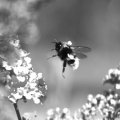Sows make individual nursing calls to communicate with their young, according to University of Queensland Veterinary Science School researcher Associate Professor Judith Blackshaw.
Dr Blackshaw said a study of sows at the University's piggery at the Veterinary Science Farm, Pinjarra Hills showed that sows could be distinguished on the basis of their vocalisations, suggesting a high level of individuality.
She said the study was the first to measure different elements of sow calls.
'It proves that an intensively housed environment, which includes heavy selection from reproduction, has not obliterated the individuality of the nursing calls that occur in the wild as well as outdoor enclosures,' she said.
'Nursing behaviour as far as the nursing calls is concerned, is not compromised by an intensively-housed environment.'
The study, co-authored by Griffith University researcher Darryl Jones, found that piglets as young as one day old responded to changes in their mother's vocalisations, in preference to an alien sow.
'Piglets responded quickly and moved very consistently towards their mother despite the background noise of other nursing sows,' Dr Blackshaw said.
'It's important for mothers to give a distinct call to their young to feed because pigs are noisy creatures.
'This nursing call has significant implications for production, and piglets' growth rate and nutrition.
'Understanding pig behaviour can help improve pig management. This study of maternal behaviour may led to changing some practices such as the time that sows are fed.'
Dr Blackshaw said sow feeding calls and mother-initiated feeding were unique behaviours among farm and domestic animals.
'Sows have developed nursing as a highly organised activity,' she said. 'A sow, which has an average of 10 piglets per litter, can't supply milk on call as other farm animals do.'
She said litters also developed a time-saving teat order as early as two days after birth.
Significant differences between sows were recorded in maximum and minimum frequency and volume measured early and late in the suckling phase for both slow and rapid grunts.
Dr Blackshaw said sows also grunted and used nose-to-nose contact to communicate with their young at non-feeding times.
'Sows don't groom their young by licking them so they come to know their young by vocalisations and smell,' she said.
For more information, contact Dr Blackshaw (telephone 07 3365 3311/5723).



